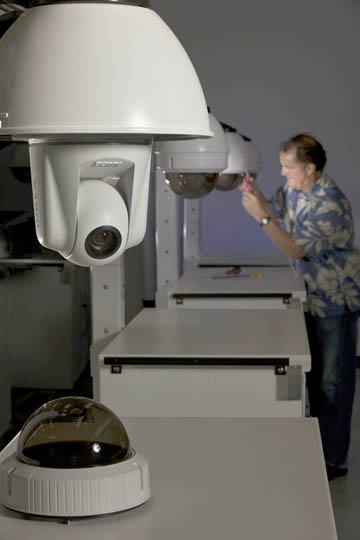
The Department of Homeland Security’s Rapidly Deployable Chemical Detection System (RDCDS), in which Sandia has played a leading development role, has made a big splash these past few years, having been deployed to venues such as the Rose Bowl in Pasadena, McAfee Stadium in Oakland, and the Democratic National Convention in Denver. Designed and built by Sandia with contributions from Lawrence Livermore National Laboratory and Pacific Northwest National Laboratory, the RDCDS provides early warning of an attack from either chemical warfare agents or toxic industrial chemicals at high-profile special events.
The RDCDS is designed to provide broad, high-confidence coverage of more than 40 different chemicals using multiple overlapping detection technologies and live video.
But Nate Gleason (8125), who serves as Sandia’s RDCDS program manager in support of the DHS program, says detection is only one part of the overall protection puzzle. So this year, armed with a $400,000 increase in DHS funding, Sandia’s researchers are moving forward with a comprehensive chemical defense architecture that goes beyond a mere detection system.
Venue selection and response time
“A detection system in isolation is useless. If you don’t do something when the detectors alarm, then why bother detecting in first place?” Nate asks.
Sandia’s emphasis, however, isn’t merely focused on response plans. Nate says the work starts with venue selection and continues systematically.
“We need to start with a full threat and vulnerability assessment of the venue and we need to figure out the possible and likely attacks on that venue,” he says. “What exactly are we protecting against? What options do the venue operators currently have that can take those threats off the table? Those are the kinds of questions we’re asking, and only then can we determine what elements from the RDCDS we can provide that will enable venue operators to execute the proper responses.”
For example, Nate says, consider a typical football stadium packed with some 60,000 spectators. A detection system, all by itself, might adequately detect a dangerous chemical release. But if it hasn’t been determined previously just how long it will take to evacuate the stadium, the detectors could prove useless if not enough warning time for emergency personnel has been allowed to usher fans out of the venue in a safe and orderly fashion.
To address these and other issues, DHS has directed Nate and his colleagues to expand the RDCDS capability on its behalf by executing two pilot activities in the coming months.
Pasadena and New York City
For the next several months, the Sandia team will focus on the Jan. 1 Rose Bowl game in Pasadena. For that event, templates and checklists are being developed to assess the venue and the surrounding area. One asset the researchers will leverage, Nate says, is existing databases on chemical infrastructure in and around Pasadena, including chemical storage tanks, plants, or even shipment routes — all considered sources of risk. This, he says, will give the team a more thorough understanding of how terrorists might plan an attack and what resources they might have available to them.
The other upcoming pilot, due to take place in the spring, will occur at New York City’s Port Authority Bus Terminal (PABT), which sees some 250,000 passengers come through its turnstiles every day. Though DHS has deployed RDCDS to other indoor venues in the past, the PABT — the world’s busiest bus terminal — presents a unique set of challenges.
Unlike other indoor venues where RDCDS has been deployed, the PABT is a facility that needs to be protected 24/7, not just for a one-time event. Though seven of the eight RDCDS detectors are capable of continuous operation, Nate says one of them currently has only a 500-hour life span, good for no more than a couple of weeks. Sandia’s RDCDS team, consequently, will replace the eighth detector for the PABT pilot and will also analyze a number of new detection technologies. In addition, biodetectors will be included in the PABT pilot, as the ultimate goal of RDCDS is a full chemical, biological, and radiological detection capability.
Sandia’s specific RDCDS customer, the Department of Homeland Security’s Office of Health Affairs, has increased the program’s funding to roughly $1.6 million this year, signifying a new level of commitment and interest in the program.
“The program seemed to be stuck in neutral for a while, with no new detection hardware and no new initiatives,” says Nate. “The new program manager has a clear vision for the RDCDS, and he seems determined to make it really worthwhile.”